Abbot, A., Button, C., Pepping, G.-J., & Collins, D. (2005). Unnatural selection: Talent identification and development in sport. Nonlinear Dynamics, Psychology and Life Sciences, 9(1). https://www.researchgate.net/publication/8102048
Abbott, A., & Collins, D. (2010). A Theoretical and Empirical Analysis of a “State of the Art” Talent Identification Model. Taylor & Francis Online, 13(2), 157–178. https://doi.org/10.1080/1359813022000048798
Abdullah, M. R., Bisyri, A., Maliki, H. M., Musa, R. M., Kosni, N. A., Juahir, H., & Haque, M. (2016). Multi-Hierarchical Pattern Recognition of Athlete’s Relative Performance as A Criterion for Predicting Potential Athletes. Journal of Young Pharmacists, 8(4), 463–470. https://doi.org/10.5530/jyp.2016.4.24
Abdullah, M. R., Nidzam, M. S., Hairi, A., Musa, R. M., Bisyri, A., Maliki, H. M., & Kosni, N. A. (2017). Prediction of Specific Physical Characteristic and Fitness Related Variables on Cardiovascular Endurance among some Selected Male Uniform Arm Units of Universiti Sultan Zainal Abidin, Malaysia. In Health & Exercise (Vol. 6, Issue 1).
Baker, J., Schorer, J., & Wattie, N. (2018). Compromising Talent: Issues in Identifying and Selecting Talent in Sport. Jörg Schorer & Nick Wattie, 70(1), 48–63.
https://doi.org/10.1080/00336297.2017.1333438
Bisyri, A., Maliki, H. M., Abdullah, M. R., Juahir, H., Abdullah, F., Ain, N., Abdullah, S., Musa, R. M., Musliha Mat-Rasid, S., Adnan, A., Azura Kosni, N., Amalina, W. S., Muhamad, W., Afiqah, N., & Nasir, M. (2017). A multilateral modelling of Youth Soccer Performance Index (YSPI) Related content The role of anthropometric, growth and maturity index (AGaMI) influencing youth soccer relative performance A multilateral modelling of Youth Soccer Performance Index (YSPI). https://doi.org/10.1088/1757-899X/342/1/012057
Fish, L. J. (2018). Why Multivariate Methods are Usually Vital. 21(3), 130–137. https://doi.org/10.1080/07481756.1988.12022895
Hart, P. D. (2018). Multivariate Analysis of Vertical Jump Predicting Health-related Physical Fitness Performance. American Journal of Sports Science and Medicine, Vol. 6, 2018, Pages 99-105, 6(4), 99–105. https://doi.org/10.12691/AJSSM-6-4-1
Hughes, M., & Bartlett, R. (2015). What is Performance Analysis? In Essentials of Performance Analysis in Sport (pp. 18–28). Routledge. https://doi.org/10.4324/9781315776743-3
Islam, M. M. (2017). A comparative study on selected physical fitness parameter among college athletes and football players. Journal of Education and Development, 7(13).
Johnston, K., Wattie, N., Schorer, J., & Baker, J. (2017). Talent Identification in Sport: A Systematic Review. Sports Medicine , 48(1), 97–109. https://doi.org/10.1007/S40279-017-0803-2
Maud, P. J. (1983). Physiological and anthropometric parameters that describe a rugby union team. British Journal of Sports Medicine, 17(1), 16–23.
https://doi.org/10.1136/BJSM.17.1.16
Nadzmi, A., Abdullah, M. R., Maliki, A. B. H. M., Renaldi, F., & Sukono. (2021). Comparison Between Gross Motor Skills Performance and 7-Years-Old Children with Controlled Effect of Residential Area. Proceedings of the First International Conference on Science, Technology, Engineering and Industrial Revolution (ICSTEIR 2020), 536. https://doi.org/10.2991/ASSEHR.K.210312.007
Pickett, C. W., Nosaka, K., Zois, J., Hopkins, W. G., & Blazevich, A. J. (2018). Maximal upper-body strength and oxygen uptake are associated with performance in high-level 200-m sprint kayakers. Journal of Strength and Conditioning Research, 32(11), 3186–3192. https://doi.org/10.1519/JSC.0000000000002398
Reilly, T., & Williams, M. (2003). Introduction to science and soccer. In Science and soccer (pp. 9–14). Routledge. https://doi.org/10.4324/9780203417553-3
Ryan, E. D., Everett, K. L., Smith, D. B., Pollner, C., Thompson, B. J., Sobolewski, E. J., & Fiddler, R. E. (2014). Acute effects of different volumes of dynamic stretching on vertical jump performance, flexibility and muscular endurance. Clinical Physiology and Functional Imaging, 34(6), 485–492. https://doi.org/10.1111/cpf.12122
Schorderet, C., Hilfiker, R., & Allet, L. (2021). The role of the dominant leg while assessing balance performance. A systematic review and meta-analysis. Gait & Posture, 84, 66–78. https://doi.org/10.1016/J.GAITPOST.2020.11.008
Silva, A. F., Ribeiro, J., Vilas-Boas, J. P., Figueiredo, P., Alves, F., Seifert, L., & Fernandes, R. J. (2019). Integrated Analysis of Young Swimmers’ Sprint Performance. Motor Control, 23(3), 354–364. https://doi.org/10.1123/MC.2018-0014
Sole, S., Ramírez-Campillo, R., Andrade, D. C., & Sanchez-Sanchez, J. (2021). Plyometric jump training effects on the physical fitness of individual-sport athletes: A systematic review with meta-analysis. PeerJ, 9. https://doi.org/10.7717/PEERJ.11004/
Sporer, B. C., & Wenger, H. A. (2003). Effects of Aerobic Exercise on Strength Performance Following Various Periods of Recovery. National Strength & Conditioning Association J. Strength Cond. Res, 17(4), 638–644.
Stockbrugger, B. A., & Haennel, R. G. (2001). Validity and Reliability of a Medicine Ball Explosive Power Test. Journal of Strength and Conditioning Research, 15(4), 431–438. https://doi.org/10.1519/1533-4287(2001)015<0431:VAROAM>2.0.CO;2
Suhaimi, M. Z., Musa, R. M., Suhaimi, M. Z., Abdullah, M. R., Husin, A. B., & Maliki, M. (2021). The Effect of Body Mass Index on Health-Related Parameters in University Students. Research J. Pharm. and Tech, 14(6). https://doi.org/10.52711/0974-360X.2021.00569
Vaeyens, R., Lenoir, M., Williams, A. M., & Philippaerts, R. M. (2012). Talent Identification and Development Programmes in Sport. Sports Medicine 2008 38:9, 38(9), 703–714. https://doi.org/10.2165/00007256-200838090-00001
Woods, C. T., Raynor, A. J., Bruce, L., McDonald, Z., & Collier, N. (2015). Predicting playing status in junior Australian Football using physical and anthropometric parameters. Journal of Science and Medicine in Sport, 18(2), 225–229.
https://doi.org/10.1016/J.JSAMS.2014.02.006
Zientek, L. R., & Thompson, B. (2009). Matrix summaries improve research reports: Secondary analyses using published literature. Educational Researcher, 38(5), 343–352. https://doi.org/10.3102/0013189X09339056
